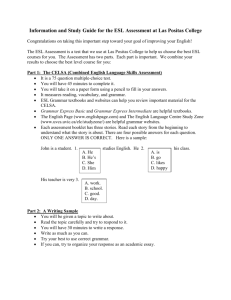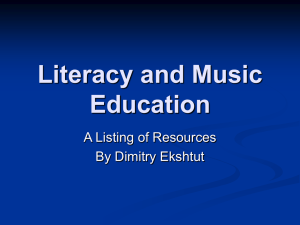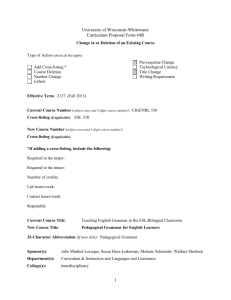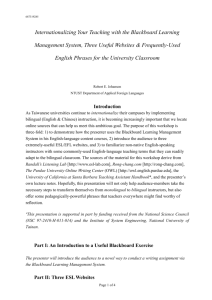ESL Level Descriptors: English Language Learning Guide
advertisement
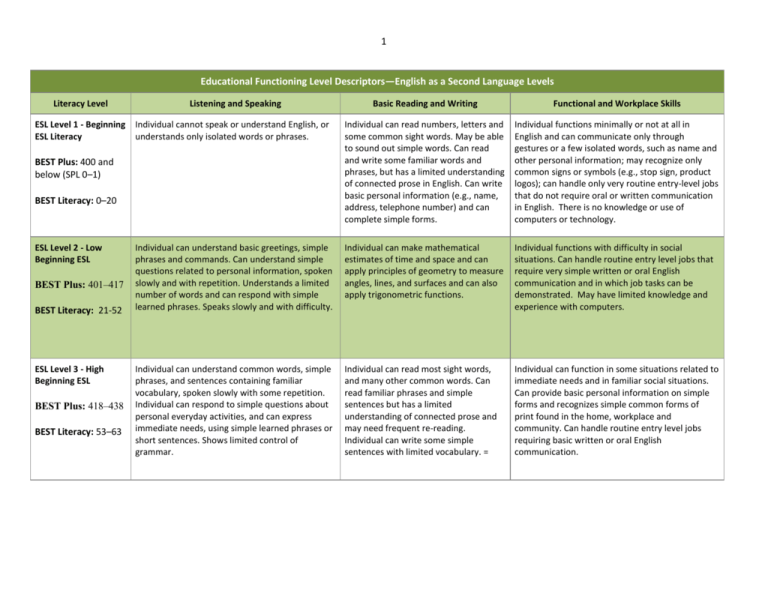
1 Educational Functioning Level Descriptors—English as a Second Language Levels Literacy Level ESL Level 1 - Beginning ESL Literacy Listening and Speaking Basic Reading and Writing Functional and Workplace Skills Individual cannot speak or understand English, or understands only isolated words or phrases. Individual can read numbers, letters and some common sight words. May be able to sound out simple words. Can read and write some familiar words and phrases, but has a limited understanding of connected prose in English. Can write basic personal information (e.g., name, address, telephone number) and can complete simple forms. Individual functions minimally or not at all in English and can communicate only through gestures or a few isolated words, such as name and other personal information; may recognize only common signs or symbols (e.g., stop sign, product logos); can handle only very routine entry-level jobs that do not require oral or written communication in English. There is no knowledge or use of computers or technology. Individual can understand basic greetings, simple phrases and commands. Can understand simple questions related to personal information, spoken slowly and with repetition. Understands a limited number of words and can respond with simple learned phrases. Speaks slowly and with difficulty. Individual can make mathematical estimates of time and space and can apply principles of geometry to measure angles, lines, and surfaces and can also apply trigonometric functions. Individual functions with difficulty in social situations. Can handle routine entry level jobs that require very simple written or oral English communication and in which job tasks can be demonstrated. May have limited knowledge and experience with computers. Individual can understand common words, simple phrases, and sentences containing familiar vocabulary, spoken slowly with some repetition. Individual can respond to simple questions about personal everyday activities, and can express immediate needs, using simple learned phrases or short sentences. Shows limited control of grammar. Individual can read most sight words, and many other common words. Can read familiar phrases and simple sentences but has a limited understanding of connected prose and may need frequent re-reading. Individual can write some simple sentences with limited vocabulary. = Individual can function in some situations related to immediate needs and in familiar social situations. Can provide basic personal information on simple forms and recognizes simple common forms of print found in the home, workplace and community. Can handle routine entry level jobs requiring basic written or oral English communication. BEST Plus: 400 and below (SPL 0–1) BEST Literacy: 0–20 ESL Level 2 - Low Beginning ESL BEST Plus: 401–417 BEST Literacy: 21-52 ESL Level 3 - High Beginning ESL BEST Plus: 418–438 BEST Literacy: 53–63 2 Educational Functioning Level Descriptors—English as a Second Language Levels Literacy Level ESL Level 4 - Low Intermediate ESL BEST Plus: 439–472 BEST Literacy: 64– 67 ESL Level 5 - High Intermediate ESL BEST Plus: 473–506 BEST Literacy: 6875 ESL Level 6 - Advanced ESL BEST Plus: 507–540 BEST Literacy: 76- Listening and Speaking Basic Reading and Writing Functional and Workplace Skills Individual can understand simple learned phrases and limited new phrases containing familiar vocabulary spoken slowly with frequent repetition; can ask and respond to questions using such phrases; can express basic survival needs and participate in some routine social conversations, although with some difficulty; and has some control of basic grammar. Individual can read simple material on familiar subjects and comprehend simple and compound sentences in single or linked paragraphs containing a familiar vocabulary; can write simple notes and messages on familiar situations but lacks clarity and focus. Sentence structure lacks variety but shows some control of basic grammar (e.g., present and past tense) and consistent use of punctuation (e.g., periods, capitalization). Individual can interpret simple directions and schedules, signs, and maps; can fill out simple forms but needs support on some documents that are not simplified; and can handle routine entry level jobs that involve some written or oral English communication but in which job tasks can be demonstrated. Individual can use simple computer programs and can perform a sequence of routine tasks given directions using technology (e.g., fax machine, computer). Individual can understand learned phrases and short new phrases containing familiar vocabulary spoken slowly and with some repetition; can communicate basic survival needs with some help; can participate in conversation in limited social situations and use new phrases with hesitation; and relies on description and concrete terms. There is inconsistent control of more complex grammar. Individual can read text on familiar subjects that have a simple and clear underlying structure (e.g., clear main idea, chronological order); can use context to determine meaning; can interpret actions required in specific written directions; can write simple paragraphs with main idea and supporting details on familiar topics (e.g., daily activities, personal issues) by recombining learned vocabulary and structures; and can self and peer edit for spelling and punctuation errors. Individual can meet basic survival and social needs, can follow some simple oral and written instruction, and has some ability to communicate on the telephone on familiar subjects; can write messages and notes related to basic needs; can complete basic medical forms and job applications; and can handle jobs that involve basic oral instructions and written communication in tasks that can be clarified orally. Individual can work with or learn basic computer software, such as word processing, and can follow simple instructions for using technology. Individual can understand and communicate in a variety of contexts related to daily life and work. Can understand and participate in conversation on a variety of everyday subjects, including some unfamiliar vocabulary, but may need repetition or rewording. Can clarify own or others’ meaning by rewording. Can understand the main points of Individual can read moderately complex text related to life roles and descriptions and narratives from authentic materials on familiar subjects. Uses context and word analysis skills to understand vocabulary, and uses multiple strategies to understand unfamiliar texts. Can Individual can function independently to meet most survival needs and to use English in routine social and work situations. Can communicate on the telephone on familiar subjects. Understands radio and television on familiar topics. Can interpret routine charts, tables and graphs and can complete forms and handle work demands that require non- 3 78 simple discussions and informational communication in familiar contexts. Shows some ability to go beyond learned patterns and construct new sentences. Shows control of basic grammar but has difficulty using more complex structures. Has some basic fluency of speech. make inferences, predictions, and compare and contrast information in familiar texts. Individual can write multiparagraph text, using some complex grammar and a variety of sentence structures. Makes some grammar and spelling errors. Uses a range of vocabulary. technical oral and written instructions and routine interaction with the public. Individual can use common software, learn new basic applications, and select the correct basic technology in familiar situations.


